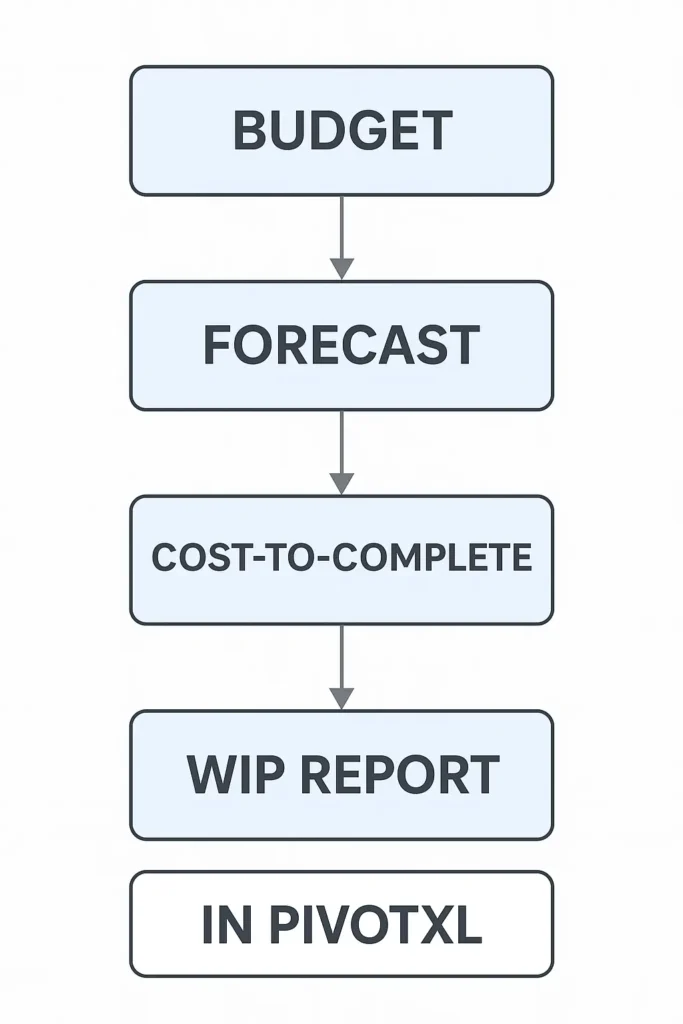In construction, the most valuable reports are the ones that show exactly where a project stands today — and where it’s heading. That’s why construction reporting software is often built around two core reports:
When these reports are accurate and up to date, they give finance teams, project managers, and executives the clarity they need to keep projects profitable and on track.
Why WIP and CTC Are at the Core of Construction Reporting
WIP Reporting
A WIP report shows:
- The original contract value.
- Revenue earned to date.
- Costs incurred to date.
- Percentage complete.
- Overbilling or underbilling amounts.
This report is essential for bonding companies, auditors, owners, and internal management. It answers: “Are we making or losing money — and how far along are we?”
Cost-to-Complete (CTC)
CTC is the forward-looking half of the equation. It estimates how much budget is still needed to finish the project. That number drives both the percent complete in the WIP report and the forecasted profit at completion.
When your CTC is accurate, your WIP becomes accurate. When your CTC is wrong, the WIP tells the wrong story.
How Budgeting and Forecasting Feed WIP and CTC
CTC and WIP don’t exist in isolation — they rely on budgeting and forecasting:
- Budgeting sets the starting point — the agreed-upon costs and margins for the job. (See how budgeting works in Excel)
- Forecasting updates those numbers based on actual performance, risks, and changes.
- Cost-to-Complete uses the forecast to calculate the remaining cost.
- WIP reporting combines actuals, forecasts, and CTC to give the most current project status.
When these steps are connected, your reporting becomes a continuous loop — always current, always reliable.
Extra Insights You Can Get from Construction Reporting Software
A good reporting system goes beyond WIP and CTC. With PivotXL, construction companies can also track:
- Project-Wise Profitability – Compare profit margins across jobs to see which types of projects or clients deliver the best returns.
- Margin Fade Trend Analysis – Identify where margins are shrinking over time, spot patterns, and take corrective action before it’s too late.
- Change Order Impact – Measure how approved and pending change orders affect projected profit and cash flow.
- Cash Flow Projections by Project – See when money is expected in and out for each job.
- Variance Analysis – Compare budget, forecast, and actual costs side-by-side to pinpoint problem areas.
- Portfolio-Level Summaries – Roll up all active projects into a single dashboard for executives and stakeholders.
By layering these insights on top of WIP and CTC, contractors can move from reactive reporting to proactive financial control.
Manual vs. Automated Reporting
| Manual Excel Reporting | Automated with PivotXL |
|---|---|
| Export job cost data from ERP | Live ERP data connection |
| Manually update CTC in multiple files | CTC updated automatically from forecasts |
| Recalculate WIP manually | WIP updates instantly |
| Multiple versions and files | One source of truth |
| Hours or days to prepare | Ready in minutes |
How PivotXL Brings It Together
PivotXL connects budgeting, forecasting, CTC, WIP, and profitability analysis in one workflow — all within Excel.
With PivotXL, you can:
- Pull actual costs directly from ERP/accounting systems.
- Allow project managers to update CTC in connected Excel templates.
- Automatically roll those updates into company-wide WIP and profitability reports.
- Run scenarios to see how changes impact profit, margin, and cash flow.
- Deliver clean, audit-ready schedules to bonding companies or owners.

Why This Matters for Construction Companies
If your WIP report is out of date, you’re flying blind. If your CTC is wrong, you risk misreporting profit and missing financial red flags. Construction reporting software ensures your budgeting, forecasting, CTC, and WIP all move together — and adds deeper insights like margin fade tracking and project profitability — giving you real-time control over project performance.
Final Word
WIP and CTC aren’t just reports — they’re the heart of construction financial management. But when paired with advanced reporting on profitability trends, margin fade, and cash flow, they become a complete decision-making system.
With PivotXL, you can automate it all, keep it tied to live data, and deliver accurate, timely reports without leaving Excel.
The result: Fewer surprises, better decision-making, and more profitable projects.



